NASA APOD #993-1001
#993 Shuttle Engine Blast March 08, 1998
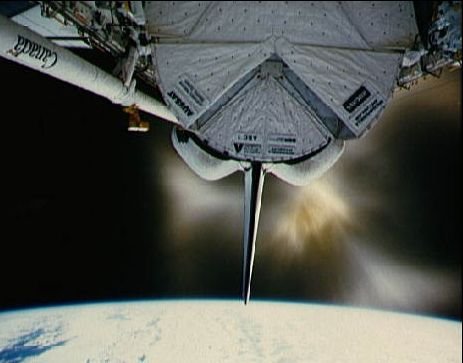
“The Space Shuttle Discovery's orbital maneuvering system (OMS) engine firing produced this dramatic flare as it cruised "upside down" in low Earth orbit. Discovery was named for a ship commanded by Captain James Cook RN, the 18th Century English astronomer and navigator. Cook's voyages of discovery established new standards in scientific exploration and brought extensive knowledge of the unknown Pacific regions, including Australia, New Zealand, and the Hawaiian Island archipelago to Europeans. The Space Shuttle Endeavor, also named after one of Cook's ships, is the most recent addition to NASA's four-orbiter shuttle fleet."
Copyright: Public domain
#994 Yogi Rock on Mars March 09, 1998
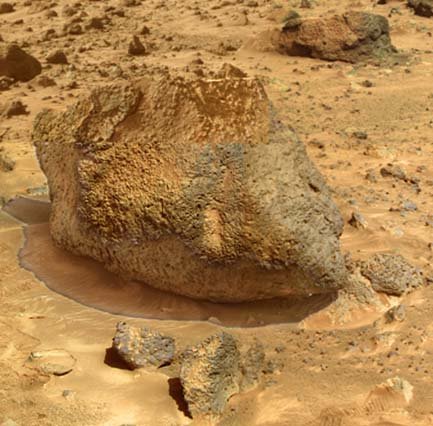
“Yogi is possibly the best photographed rock on Mars. By combining many pictures taken during the Mars Pathfinder Mission last year, scientists were able to create a super-resolution, digitally enhanced image that better allows them to study Yogi's surface and more accurately determine how Yogi was formed. The smoothness of some Martian rocks suggests previous interactions with water, implying that Mars was both warmer and wetter in the past."
Copyright: Public domain
#995 Cracks and Ridges on Europa March 10, 1998
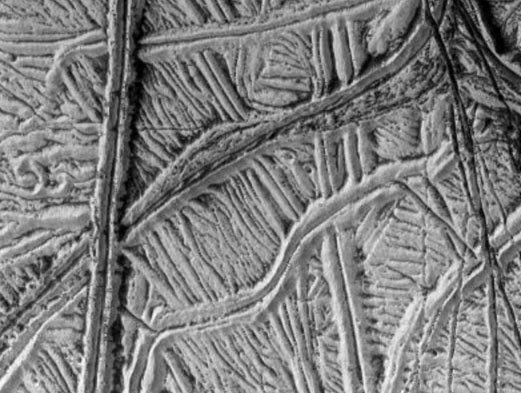
“Which way to the interstate? What appears to be a caricature of a complex highway system on Earth is actually a system of ridges and cracks on the icy surface of Jupiter's moon Europa. The distance between parallel ridges in the above photograph is typically about 1 kilometer. The complexity of the cracks and ridges tell a story of Europa's past that is mostly undecipherable -- planetary geologists try to understand just the general origin of the overall features. One noteworthy feature is the overall white sheen, possibly indicating the presence of frost. Another is the dark centers between parallel ridges, which might indicate that dirty water from an underground ocean recently welled up in the cracks and froze."
Copyright: Public domain
#996 A Total Eclipse of the Sun March 11, 1998
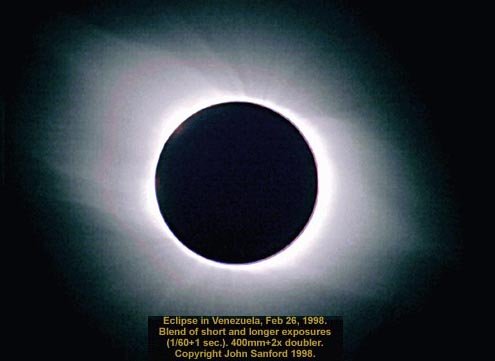
“On February 26th, it was dark during the day. This total solar eclipse was the last visible from the Americas for this millennium. A total solar eclipse is exciting partly because it is so short. Were Earth's Moon farther away, no total eclipse would occur at all because the Moon would appear too small to block out all of the Sun. Were the Moon much closer to the Earth, the eclipse would last much longer. Oddly, the Sun and Moon have almost exactly the same angular size. Even for well located observers, this creates at most only a very few minutes of totality before the Moon's shadow moves away. During a total solar eclipse in 1919, these few minutes were long enough for scientists to determine that the Sun's gravity bends light from the stars behind it, dramatically confirming the accuracy of a new theory of gravity postulated over 80 years ago."
Copyright: J. Sanford
#997 Moon Shadow March 12, 1998
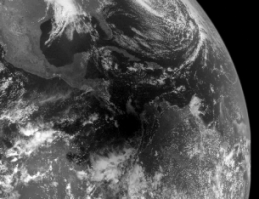
“When the Moon's shadow reached out and touched the Earth last month, the result was a Solar Eclipse. Such an eclipse is total only for observers located along a narrow path corresponding to the ground track of the shadow's dark central portion or "umbra". For this eclipse, racing along at nearly 1,200 miles per hour, the Moon's umbra obligingly crossed over land along pleasant tropical locales in South America and the Caribbean islands. Totality lasted for about 3 minutes or less at a given location. Sizable fractions of North and South America fell within the lighter but much wider outer shadow region, the "penumbra", and witnessed a partial eclipse. This movie gif follows the Moon's shadow from Central and South America eastward across the Atlantic - as seen from the vantage point of an orbiting Geostationary Operational Environmental Satellite (GOES), 22,000 miles above Earth. The three frame animation spans about 2 hours. GOES satellite images are a corner stone of U.S. weather monitoring and forecast operations."
Copyright: Public domain
#998 Asteroids March 13, 1998
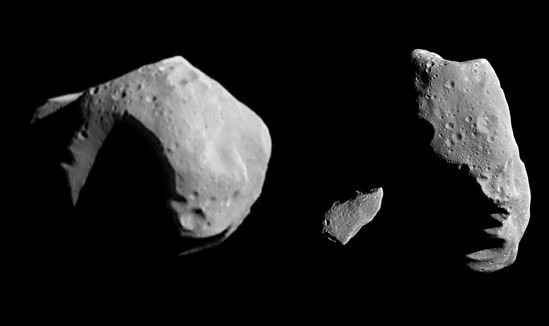
“No asteroid or comet is known to be on a collision course with Earth. The asteroid designated 1997 XF11 had been predicted to come uncomfortably close, but new estimates place its passing beyond the orbit of the Moon. This earth-approaching asteroid was discovered by SpaceWatch astronomer Jim Scotti in December of last year. Orbital computations using new observations suggested that it would pass within 30,000 miles of the Earth's center on October 26, 2028 - a very near miss considering that the radius of the Earth itself is about 4,000 miles. However, more recent and further refined calculations based on both new and archival data indicate that the closest approach will be 600,000 miles in 2028. Imaged by NASA spacecraft, the three potato-shaped objects above are large main-belt asteroids orbiting between Mars and Jupiter. Shown to the same scale from left to right are Mathilde, Gaspra, and Ida. Mathilde has dimensions of about 37 by 29 miles. The asteroid 1997 XF11 is much smaller, probably a mile wide, yet the impact of an asteroid of this size could have catastrophic effects. Over the last two decades, teams of astronomers have just begun to catalog and track near-earth objects."
Copyright: Public domain
#999 A Spiral Galaxy Gallery March 14, 1998
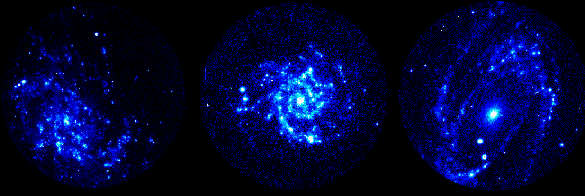
“A progression of beautiful spiral galaxies is illustrated above with three photographs from NASA's Ultraviolet Imaging Telescope (UIT). Flying above the Earth's obscuring layer of atmosphere on the Space Shuttle Columbia during the Astro-1 mission in 1990, UIT's cameras were able to image these distant spirals in the ultraviolet light produced by hot, young stars. These bright stars, newly condensed from gas and dust clouds, give away the location of the spiral arms they are born in. Because they are massive (many times the mass of the Sun), they are shortlived. Dying and fading before they move too far from their birth place they make excellent tracers of spiral structure. From left to right the galaxies are known as M33, M74, and M81 and have progressively more tightly wound spiral arms. Astronomers would classify these as Scd, Sc, and Sb type spirals using a galaxy classification scheme first worked out by Edwin Hubble."
Copyright: Public domain
#1000 Unusual M82: The Cigar Galaxy March 15, 1998
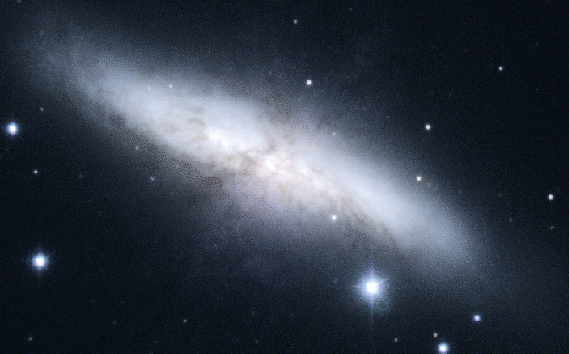
“Something strange happened to this galaxy, but what? M82 is a nearby galaxy in the group of galaxies dominated by itself, M81, and NGC 3077. M82 is thought by some to be limping away from a close encounter with M81. This galactic collision might have stirred up the inner stars and gas in M82, causing the unusual dark lanes of dust visible in the above photograph. M82 is a starburst galaxy with a very active center containing star clusters far brighter than any in our own Milky Way Galaxy."
Copyright: CfA1.2-m TelescopeWhipple Observatory
#1001 Asteroids in the Distance March 16, 1998
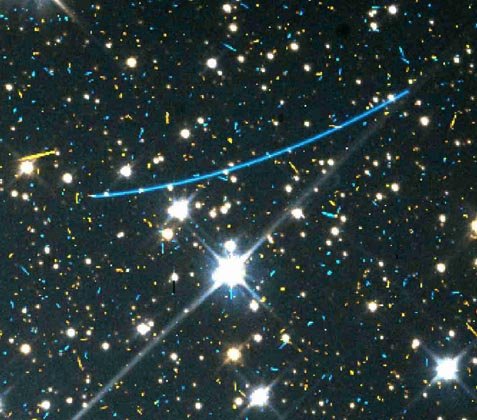
“Rocks from space hit Earth every day. The larger the rock, though, the less often Earth is struck. Many kilograms of space dust pitter to Earth daily. Larger bits appear initially as a bright meteor. Baseball-sized rocks and ice-balls streak through our atmosphere daily, most evaporating quickly to nothing. Significant threats do exist for rocks near 100 meters in diameter, which strike Earth roughly every 1000 years. An object this size could cause significant tidal waves were it to strike an ocean, potentially devastating even distant shores. A collision with a massive asteroid, over 1 km across, is more rare, occurring typically millions of years apart, but could have truly global consequences. Many asteroids remain undiscovered. In fact, the discovery of several was announced last week; one is shown as the long blue streak in the above photograph. Such an interplanetary collision would not affect Earth's orbit so much as raise dust that would affect Earth's climate. One likely result is a global extinction of many species of life, possibly dwarfing the ongoing extinction occurring now."
Copyright: Public domain
Upvote! Resteem! Comment! As you like it! Thank you for attention!